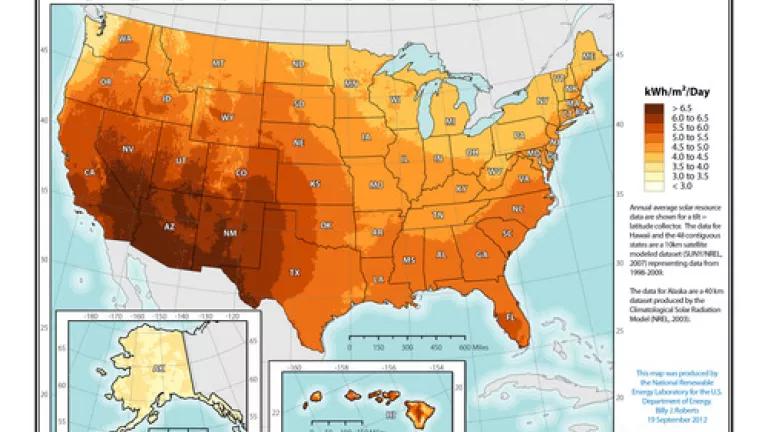Florida's Energy Efficiency and Solar Resources Are Ripe For The Picking, Our New Report Shows

Growing up, I watched a lot of orange juice commercials that showed Florida citrus trees almost overflowing with fruit. (Sunshine State, my apologies for even mentioning this in the midst of your current citrus crisis. )
That image of trees heavy with fruit keeps coming to mind as NRDC releases a new report, co-authored with my colleague Katharine McCormick, on how Florida can best comply with the EPA’s Clean Power Plan to cut greenhouse gas emissions from the nation’s power plants; as the Florida Public Service Commission, the state’s utility regulator, simultaneously deliberates its mandated five-year review of the state’s energy efficiency goals and solicits comments on how the state can best comply with the CPP (you can check out the questions the PSC wants addressed and get the email address for comments here); and, as utilities in the state propose a mind-blowing 97 percent cut in Florida’s currently minimal efficiency programs. (More on that later.)
The reason that image of Florida’s abundance keeps popping into my head is simple: Florida’s energy efficiency and solar energy resources are as plentiful as the fruit on those trees. Taking advantage of these resources will not only help Florida, a state uniquely vulnerable to climate change, comply with the CPP. It will do all kinds of great things for the Sunshine State.
First off, according to an NRDC analysis, ramping up energy efficiency programs, rather than effectively destroying them with cuts of 97 percent, can create 10,000 new jobs in Florida’s energy efficiency sector alone. Plus, because energy efficiency helps us do more stuff with less power, there’s money to be saved on electric bills, rather than seeing electricity costs rise as demand in Florida increases. Add to all that the fact that ramping up energy efficiency to 2 percent of Florida annual year-over-year utility sales can cut 11.4 million tons of carbon pollution in 2020—the equivalent of taking 2.4 million cars off Florida’s roads—and you’ve got yourself an impressive package.
The Sunshine State, appropriately enough, also has an incredible solar resource. It can help save Floridians money on energy, create jobs and cut carbon pollution from power plants, even if, right now, its potential remains relatively untapped. (Just check it out on this map from the National Renewable Energy Laboratory, below.) In fact, Florida can get a mind-blowing 70 percent of its electricity from solar.
As this map from the National Renewable Energy Laboratory shows, Florida's solar resources are some of the best in the nation.
Of course, solar will save the individual homeowners and business owners who use it money on energy, especially as solar’s price continues its eye-popping drop. But it will do more than that. Because solar produces the most power when demand is highest, on hot days when the most expensive and polluting power plants come online, solar reduces electric prices and improves public health for everyone.
As the PSC gets to work, let’s consider the facts that argue in favor of a lot more energy efficiency and solar, not a lot less. (By the way, utilities are arguing for huge cuts in energy efficiency programs, in part, because Florida has structured its utility markets so that utilities make more money when they sell more power. Things don’t have to be that way. Indeed, that’s not the case in 16 states. Through a policy called “decoupling,” the PSC can ensure utilities receive the right return on their investments, even as efficiency reduces the amount of electricity they sell.)
Again, the facts:
• Thanks to serious air-conditioning use in the summer and electric heat during the winter, the average Sunshine State household spends 40 percent more on energy than the average American one does—a wallet-walloping $1,900 a year.
• Energy efficiency is the least expensive way for Florida to meet its electricity needs—cheaper than coal and cheaper than natural gas.
• Florida’s energy efficiency potential remains largely untapped. In 2012, its energy savings were only 0.27 percent of utilities’ retail sales, compared to a better but still lethargic 0.58 percent for the U.S. average. (In some states, like Vermont, California and Massachusetts, those numbers are far higher.)
• Florida utilities can ramp up their energy savings fast. Gulf Power, a Southern Company subsidiary in northwest Florida with 430,000 customers, increased its energy savings from 0.07 percent in 2010 to 0.9 percent by 2013. There’s no reason utilities can’t cost-effectively get to 2 percent annual savings by 2020.
• The solar industry, which currently supplies only about less than 0.1 percent of Florida’s power, employs about 4,000 Floridians at 306 solar companies. If Florida improves its solar policies—by adopting a renewable energy standard, as 29 states already have, and allowing third-party ownership, which is driving so much solar growth nationwide, for instance—those numbers can skyrocket as solar cuts both carbon pollution and energy prices across the state.
Now, it’s time for the PSC to consider the implications of its plans. Does it want to create jobs, cut energy costs for consumers and address the carbon pollution that is already impinging on Florida’s safety and well-being? Or, would it rather reward utilities for selling more polluting power when it could instead change the way they’re compensated and reward them for selling less?
Why not reap the full benefits of some of the Sunshine State’s most plentiful assets—its energy efficiency and solar power potential? Citrus, sadly, is having a rough go of it. But Florida’s abundant energy efficiency and solar resources are ready to be picked off the trees.

